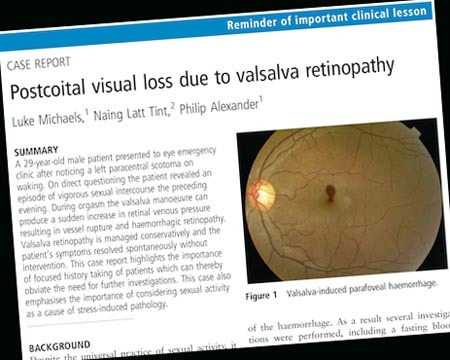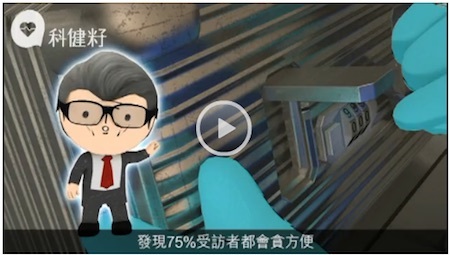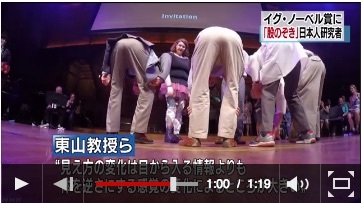Marc Abrahams's Blog, page 236
December 12, 2016
Nothing, to sneeze at: How to create a press release from nothing
 Most news reports about science and medicine come from press releases, some of which contain a colorful statement and some padding, but no actual news. This press release from Texas A&M University shows how that’s done at the highest professional level:
Most news reports about science and medicine come from press releases, some of which contain a colorful statement and some padding, but no actual news. This press release from Texas A&M University shows how that’s done at the highest professional level:
Can you sneeze with your eyes open?
…David Huston, MD, associate dean of the Texas A&M College of Medicine Houston campus and an allergist at Houston Methodist Hospital, said it is “absolutely possible” to sneeze without closing the eyes, but most people tend to automatically close their eyes when sneezing….
That press release — a splendid specimen of its kind — contains additional text that pads the document out to more than a full page in length.
The photo you see here shows David Huston, MD, associate dean of the Texas A&M College of Medicine Houston campus and an allergist at Houston Methodist Hospital, with his eyes open.
(Thanks to Tony Tweedale for bringing this to our attention.)

December 11, 2016
A Chinese appreciation of Professor Trinkaus’s password-guessing research
John Trinkaus, who was awarded the 2003 Ig Nobel Literature Prize for publishing more than 80 detailed academic reports about things that annoyed him, got some recent attention for his how-well-do-people-guess-at-passwords research. The Chinese Apple site produced this video about that:
Here’s a machine translation into English of part of what it says:
“John Trinkaus, a professor at the City University of New York, found that 75 percent of respondents bought their suitcases and the passwords would remain intact. There are many reasons, but the main are lazy, that one thousand to remember, and some also said that when the customs clearance to facilitate easy to open inspection and so on. Therefore, the human head is not difficult to guess, may not be able to get out of Holmes can get. In addition, Professor Trinkaus had an experiment years ago, with hundreds of students between 50 to 100 to pick a double number. If it is you, you will guess which they pick the original most people will eventually choose 68.”
The report cites two of Professor Trinkaus’s studies:
“The attache case combination lock: an informal look,” John Trinkaus, Perceptual and motor skills 72, no. 2 (1991): 466-466.
“Preconditioning an audience for mental magic: An informal look,” John Trinkaus, Perceptual and Motor Skills (1980).
The report combines Trinkaus’s insights with those of Richard Feynman, who as a young physicist working on a top secret project discovered the secret of opening safes in top secret places. Here’s a video about the Feynman story:

Ig Nobel at the planetarium in Milan, on December 15
Planetario di Milano is doing a special public program about the Ig Nobel Prizes, on Thursday, December 15:
Giovedì 15 dicembre, alle ore 21, presentazione di ricerche che prima fanno ridere e poi fanno riflettere con Luca Perri e in “Ignobel – Scienziati squilibrati“.

December 10, 2016
Effects of Red Wine on Pre-Hotdogs
Initial progress is reported on understanding what can happen if you add red wine to hot dogs before the hot dogs are fully hot dogs. This study explains:
 “Effects of adding red wine on the physicochemical properties and sensory characteristics of uncured frankfurter-type sausage,” Xi Feng [pictured here], Joseph G. Sebranek, Hyun Yong Lee, Dong Uk Ahn, Meat Science, vol. 121, November 2016, pp. 285–291. The authors, at Iowa State University, report:
“Effects of adding red wine on the physicochemical properties and sensory characteristics of uncured frankfurter-type sausage,” Xi Feng [pictured here], Joseph G. Sebranek, Hyun Yong Lee, Dong Uk Ahn, Meat Science, vol. 121, November 2016, pp. 285–291. The authors, at Iowa State University, report:
“The aim of this work was to evaluate the quality and sensory characteristics of RTE frankfurter-type sausage cured with celery juice powder and including red wine…. Results showed that adding 5% red wine increased the a*-value, and the textural resilience, cohesiveness and springiness of the frankfurters, as well as decreased lipid/protein oxidation of the final products. Added wine also introduced new volatiles (alcohol and ester compounds) to the frankfurters…. However, the addition of excess amounts of red wine (10%) to the meat batter decreased the pH of meat batter and accelerated lipid oxidation.”

December 9, 2016
Some video reports about the 2016 Ig Nobel Prize winners
Here’s a smattering of TV news reports about the 2016 Ig Nobel Prize winners and the ceremony. If you look down your nose at television, perhaps begin by reading some wire service reports: Associated Press, Reuters (and a trove of Reuters photos), AFP. LiveScience took many photos.
NHK [Japan]:
CTV Winnipeg [Canada]:
CIS [Russia]:
Magellan SuperTV2 [Hungary]:
Teleitalia [Italy]:
News TV:
CCTV America [China]:
CCTV News [China]:
Otago Daily Times [New Zealand]:
Chuyển Động | Đề Cử Giải Ig Nobel Tại Việt Nam | Tin Hot:
CNN News:
World News Russia Ukraine:
For additional reports, see the Improbable Research press clips page.
NEXT POST: Red wine on pre-hotdogs?

December 8, 2016
The cause of 85% of homosexuality, according to the SSRF
 The vast majority — approximately 85% — of cases of homosexuality in humans are caused by ghosts, says a report by the Spiritual Science Research Foundation (also known as “the SSRF”). The organization does not say what percentage of its reports are written or otherwise caused by ghosts. Their homosexuality/ghosts report says:
The vast majority — approximately 85% — of cases of homosexuality in humans are caused by ghosts, says a report by the Spiritual Science Research Foundation (also known as “the SSRF”). The organization does not say what percentage of its reports are written or otherwise caused by ghosts. Their homosexuality/ghosts report says:
Spiritual research has shown that the cause for homosexual preferences lie predominantly in the spiritual realm.
Physical causes (5%): Due to hormonal changes.
Psychological causes (10%): Having an experience with a person of the same sex as a teenager or young adult that was pleasurable and therefore wanting to experience it again.
Spiritual causes (85%): Mainly ghosts.
This finding is interesting if true.
The organization produced a lengthy video about many of their other discoveries, all of which may have as much merit as their discovery that the vast majority — approximately 85% — of cases of homosexuality in humans are caused by ghosts:
The LGBTQ Nation web site offers an informed appreciation of the study.
(Thanks to Scott Langill for bringing this to our attention.)

Correct measurement of the wing-length of waders (recommendation)
Those involved in research projects often need to take measurements of some kind, and usually, the more accurate the better – leading to the question ‘Can any measurement ever be taken without some margin of error?’ As an example, see the work of Professor P R Evans, writing in the Wader Study Group Bulletin, (69, Special Issue):97-98, 1993. Correct measurement of the wing-length of waders
“It has been drawn to my attention that there is some confusion as to the most reliable method of measuring the wing-length of waders, i.e. the method that minimizes differences in measurements obtained from the same bird by different workers on the same occasion, or by the same worker on different occasions.”
Also see: Curiosity: “ZERO margin of error”?
NEXT POST: Do the winners show up on TV?

December 7, 2016
Did His Orgasm Lead to Blindness? (podcast #93)
Can a man’s orgasm cause him to go blind, at least temporarily? A medical report explores that very question, and we explore that medical report, in this week’s Improbable Research podcast.
SUBSCRIBE on Play.it, iTunes, or Spotify to get a new episode every week, free.
This week, Marc Abrahams discusses a published orgasm/blindess study, with dramatic readings from Yale/MIT/Harvard biomedical researcher Chris Cotsapas.
For more info about what we discuss this week, go explore:
“Postcoital Visual Loss Due to Valsalva Retinopathy,” Michaels, Luke, Naing Latt Tint, and Philip Alexander, BMJ Case Reports, epub October 23, 2014.
The Valsalva maneuver, and its clinical implications.

The mysterious John Schedler or the shadowy Bruce Petschek perhaps did the sound engineering this week.
The Improbable Research podcast is all about research that makes people LAUGH, then THINK — real research, about anything and everything, from everywhere —research that may be good or bad, important or trivial, valuable or worthless. CBS distributes it, on the CBS Play.it web site, and on iTunes and Spotify).
NEXT POST: Is every measurement wrong?

December 6, 2016
A mathematician’s happy diatribe about what happens when mathematicians gather
Doron Zeilberger cast a wary glance at the social gathering habits of his fellow mathematicians. He wrote a little, gleeful diatribe about it:
Opinion 104: The Shocking State of Contemporary “Mathematics”, and the Meta-Shocking Fact that Very Few People Are Shocked
I just came back from attending the 1052nd AMS (sectional) meeting at Penn State, last weekend, and realized that the Kingdom of Mathematics is dead. Instead we have a disjoint union ofnarrow specialties, and people who know everything about nothing, and nothing about anything (except their very narrow acre). Not only do they know nothing besides their narrow expertise, they don’t care!
The “meeting” was not really a meeting. It was many mini-meetings! 22 of them, running in parallel and in complete oblivion of each other. All that they shared was the coffee, tea, and donuts. That’s a little reassuring that an algebraic combinatorialist has at least one thing in common with an algebraic geometer, a q-serieser, and a Heat-kernel group theorist: they all drink coffee (or tea), and eat donuts! But that’s about it….
Each speaker had a special session associated with his narrow specialty, so naturally between 20 to 30 people for each talk were a captive audience. It would be really in bad taste to play hookey on the talk of the organizer of your special session….
You can’t really blame the audience for not showing up, since they were probably burnt out from countless previous invited talks where they didn’t understand a word, or from reading the very technical abstracts of the current talks. Most speakers have no clue how to give a general talk. They start out, very nicely, with ancient history, and motivation, for the first five minutes, but then they start racing into technical lingo that I doubt even the experts can fully follow.
Please! Expand these first five minutes into fifty minutes, tell us about the history, background, motivation, and you don’t have to even mention your own results.
BONUS (possibly related): Claire Kamp Dush’s “How Structural Equation Modeling is Ruining Family Research”
NEXT POST: Is every measurement wrong?

December 5, 2016
Dirty Money (a comprehensive review)
Before you reach into your pocket, bag, purse or wallet for some cash … you might pause for thought about the bacteria, yeasts, fungi, cysts and ova of intestinal parasites that could be lurking there.
All the above are commonly found on money worldwide – but which types of cash are the filthiest? In a comprehensive roundup of global research into money and its disease-causing potential, researchers Emmanouil Angelakis, Esam I Azhar, Fehmida Bibi, Muhammad Yasir, Ahmed K Al-Ghamdi, Ahmad M Ashshi, Adel G Elshemi and Didier Raoult have examined various physical forms of cash to determine which might be the most problematic.
They note that paper (i.e. cotton and linen based) notes are particularly bad (in Ghana, 100% of the currency notes tested were found to be contaminated with one or more bacterial species). Plastic (i.e. polymer) notes were considerably cleaner (polymer-based banknotes from Australia and New Zealand presented less than 10/cm2 bacteria). And coins – particularly those rich in copper, were also less contaminated than the paper (possibly due to the antibacterial properties of some metals).
The research team suggest that :
“The capacity of banknotes, coins and fomites* to serve as sources of pathogenic agents represents a major challenge in the 21st century. It is possible that the replacement of cotton-based banknotes by substrate material can play an important role in the reduction of bacterial concentration.”
REFERENCE: ‘Paper money and coins as potential vectors of transmissible disease’ in Future Microbiology (2014) 9(2), 249–261
*NOTE: A ‘fomite’ is any non-living entity that can transmit disease – like, say, a church font, or a doorknob
BONUS[1] ‘Microbiology: A Very Short Introduction’ by Professor Money
BONUS[2]: A look at another type of dirty money
NEXT POST: Can mathematicians understand each other?

Marc Abrahams's Blog
- Marc Abrahams's profile
- 14 followers









